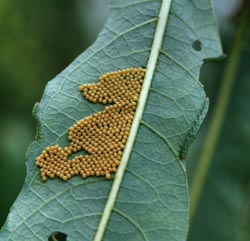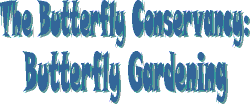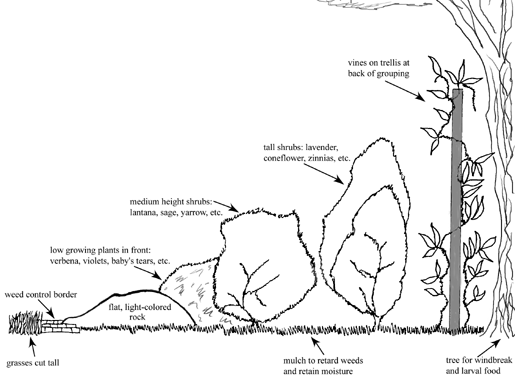

![]() Create
your butterfly garden design in a manner similar to the picture shown
below, to give them a windbreak, and provide a variety of food
sources, both nectar and larval, for the different types of native butterflies
you are trying to attract. If planting a large area, you could place your
taller plants in the center, planting in decreasing heights in a circle
around the tall plants. This way you can plant several types of plants
with different sun/shade requirements, and then observe the butterflies
to see which they prefer to help plan your plant choices in future years.
Create
your butterfly garden design in a manner similar to the picture shown
below, to give them a windbreak, and provide a variety of food
sources, both nectar and larval, for the different types of native butterflies
you are trying to attract. If planting a large area, you could place your
taller plants in the center, planting in decreasing heights in a circle
around the tall plants. This way you can plant several types of plants
with different sun/shade requirements, and then observe the butterflies
to see which they prefer to help plan your plant choices in future years.
![]() It is
better to plant with flower colors in groupings of similar hues, rather
than mixing the colors indiscriminately, as this has been observed to
be a preferred attractant for butterflies.
It is
better to plant with flower colors in groupings of similar hues, rather
than mixing the colors indiscriminately, as this has been observed to
be a preferred attractant for butterflies.
![]() Remember
that you absolutely, positively CANNOT USE INSECTICIDES in your
butterfly garden, or you will kill the butterflies and caterpillars!!
Use natural biological pest controls only.
Remember
that you absolutely, positively CANNOT USE INSECTICIDES in your
butterfly garden, or you will kill the butterflies and caterpillars!!
Use natural biological pest controls only.

![]() The following
list includes a variety of nectar plants that will attract butterflies.
When creating a butterfly garden, the size of the flower is important
as to whether a species of butterfly can nectar on it. Larger, trumpet
shaped flowers are used by larger butterflies (which have a longer proboscis),
while smaller butterflies require shorter tubed flowers on which to nectar.
Try not to purchase nectar plants that have been heavily hybridized to
create double flowers, as these are generally poor nectar producers. In
descending order of color preference, butterflies seem to prefer flowers
that are red, yellow, orange, purple, pink, blue or white.
The following
list includes a variety of nectar plants that will attract butterflies.
When creating a butterfly garden, the size of the flower is important
as to whether a species of butterfly can nectar on it. Larger, trumpet
shaped flowers are used by larger butterflies (which have a longer proboscis),
while smaller butterflies require shorter tubed flowers on which to nectar.
Try not to purchase nectar plants that have been heavily hybridized to
create double flowers, as these are generally poor nectar producers. In
descending order of color preference, butterflies seem to prefer flowers
that are red, yellow, orange, purple, pink, blue or white.
| Impatiens Joe-Pye Weed (Eupatorium) Lantana Lavender Lavender Tree Marigold Obedience Plant Passion Vine (Passiflora) Penstamon Pentas Salvia Sedum Sunflower Verbena Yarrow Zinnia |
![]() Below are
some common North American butterfly species and their preferred larval
or host plants. Some larval plants are also nectar plants. Be aware that
virtually any plant purchased from a commercial nursery has been thoroughly
doused with insecticides, and may also have systemic pesticides in its
soil. You should repot all non-organically grown plants in fresh soil,
and rinse leaves and flowers repeatedly for at least a week before introducing
them to your butterfly garden.
Below are
some common North American butterfly species and their preferred larval
or host plants. Some larval plants are also nectar plants. Be aware that
virtually any plant purchased from a commercial nursery has been thoroughly
doused with insecticides, and may also have systemic pesticides in its
soil. You should repot all non-organically grown plants in fresh soil,
and rinse leaves and flowers repeatedly for at least a week before introducing
them to your butterfly garden.
| Butterfly
Species
|
Larval
Plant
Grasses, Sedges |
![]() Learn how
to design a garden that encourages butterflies to visit and reproduce.
With appropriate plants and an insect-friendly environment, you can attract
these beautiful creatures to any size garden, regardless of your climate
or urban setting. Classes are taught by many Garden Clubs, Museums, etc.
Learn how
to design a garden that encourages butterflies to visit and reproduce.
With appropriate plants and an insect-friendly environment, you can attract
these beautiful creatures to any size garden, regardless of your climate
or urban setting. Classes are taught by many Garden Clubs, Museums, etc.
![]() There are
many fine butterfly gardening reference texts that are specific to your
area of the country; check in any bookstore or library. My personal favorites
include:
There are
many fine butterfly gardening reference texts that are specific to your
area of the country; check in any bookstore or library. My personal favorites
include:
- Audobon Society's Field Guide to North American Butterflies, by Robert M. Pyle
- Peterson's First Guide to Caterpillars, by Amy Bartlett Wright
- Garden Butterflies of North America and How to Attract Them, by Rick Mikula
- Butterfly Gardening, Luring Nature's Loveliest Pollinators to Your Yard, from the Brooklyn Botanic Garden Press